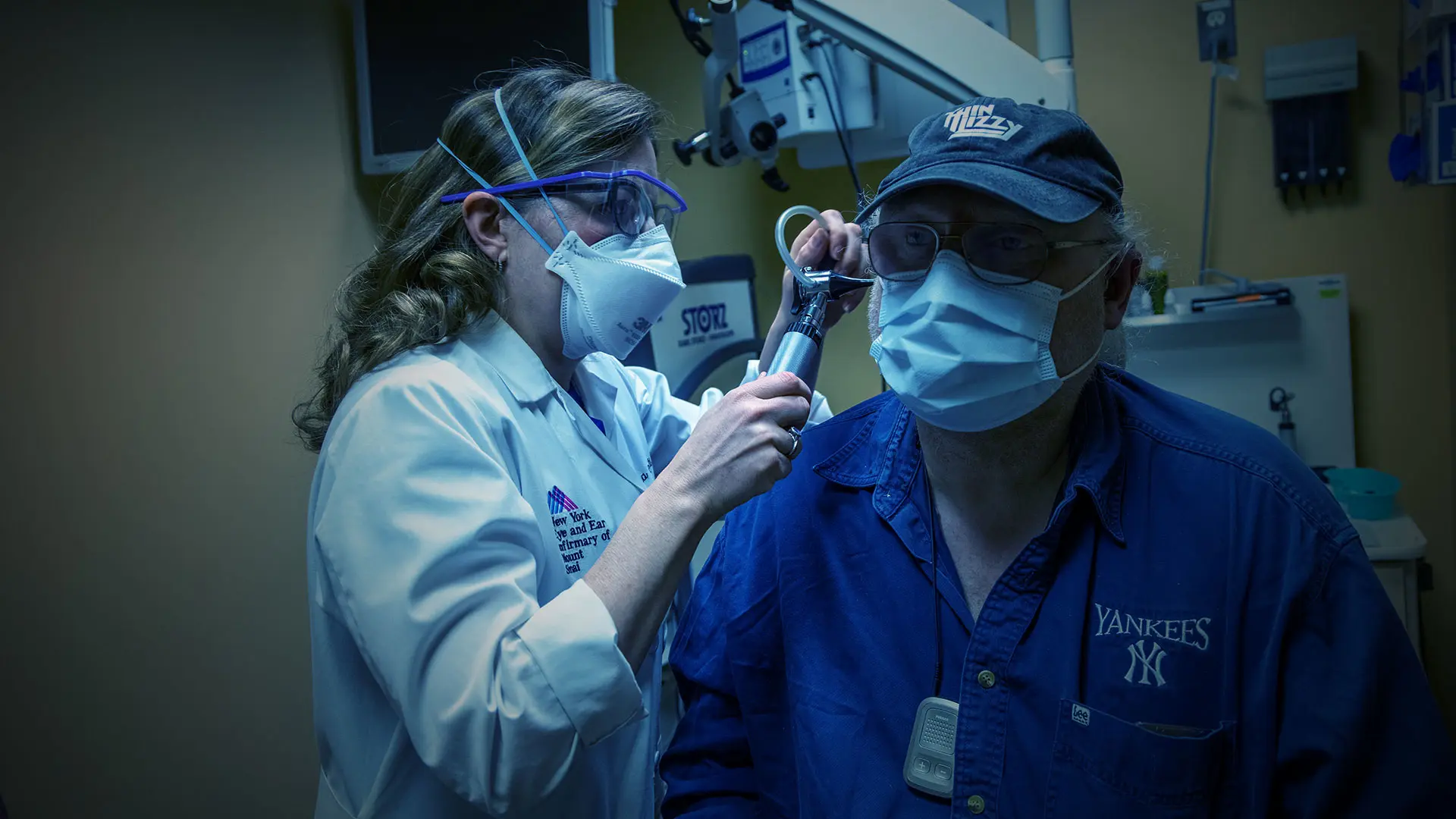When the U.S. Food and Drug Administration (FDA) approved cochlear implantation in 2019 for single-sided deafness, it offered a new treatment modality for patients who previously had few options. But the approval raised questions as to which patient population would benefit from implantation—questions that researchers such as Maura K. Cosetti, MD, Director of the Ear Institute at New York Eye and Ear Infirmary of Mount Sinai, are exploring.
“At the Ear Institute, we implant adult and pediatric patients for every current indication, and we are one of the few in the world that have extensive experience in single-sided deafness,” says Dr. Cosetti, who is an Associate Professor of Otolaryngology-Head and Neck Surgery, and Neurosurgery at the Icahn School of Medicine at Mount Sinai. “We are looking at the unilateral hearing loss population through a couple of studies to gain more insights on the benefits of implantation based on the challenges they face.”
Using Virtual Reality to Assess Real-World Benefits
One study is a National Institutes of Health (NIH) clinical trial exploring sensory integration and balance among patients with single-sided deafness and those with loss of vestibular function. Although studies have shown that hearing loss and vestibular disorders are associated with a threefold increase in fall risk, Dr. Cosetti says it is not known why this is the case or whether the same is true for patients with single-sided deafness. In partnership with Anat Lubetzky, PhD, Associate Professor of Physical Therapy at NYU Steinhardt School of Culture, Education, and Human Development, as well as a team of auditory engineers and vestibular therapists, Dr. Cosetti and the team are investigating the link between hearing loss and balance, such as in fall risk.
“We aim to understand how people with single-sided deafness and those with vestibular hypofunction navigate common, but complex sensory environments,” says Dr. Cosetti. “These observations will help us better characterize the challenges faced by patients with a deaf ear and, ultimately, the way in which cochlear implantation can have a positive impact for those patients.”
Participants selected for the study will be grouped in three cohorts: patients with unilateral peripheral vestibular hypofunction (45), participants with single-sided deafness (45), and an age-matched control group (45). All participants use a virtual reality headset to navigate two settings: one that is contextual (e.g., a subway station, airport, busy street) and one that is abstract (e.g., a display of stars), while standing on a force-plate. The amount of visual and auditory stimuli are varied to assess the response of three-dimensional head position, postural sway, and center of pressure. Dr. Cosetti will follow the cohorts to assess whether sounds are crucial for balance, and which mechanism is involved; whether individuals with unilateral hearing loss but no vestibular issues have balance problems; and whether individuals with vestibular loss are destabilized by sound.
“Previous studies suggest that sounds provide an audio anchor that is crucial to balance, but many of those studies were done using blocked visuals,” Dr. Cosetti explains. “That’s not an accurate representation of what people experience in their daily lives. Using virtual reality, we can replicate the environments they regularly encounter while testing their balance and posture. This will provide a better understanding of the challenges faced by this population and how they compensate.”
Using virtual reality technology, Dr. Cosetti’s study emphasizes the importance of investigating balance deficits in complex, ecologically valid environments. It demonstrated that older patients with unilateral hearing loss—and without other deficits—performed worse in complex, dynamic settings.
But age may not be the only factor impacting balance and fall risk in those with single-sided deafness. In a pilot study, Dr. Cosetti and her colleagues found that the severity of hearing loss was more predictive of poor dynamic balance than age or even prior vestibular dysfunction. Gait speed was found to be slower in individuals with single-sided deafness, regardless of age.
“What’s becoming incredibly evident is that single-sided deafness has a clear impact on people of all ages, including their sense of dynamic balance and response to changes in their environment,” says Dr. Cosetti. “One of our theories is that attention is the linking feature—that those with hearing loss have to use more of their cognitive resources and attention to navigate their environment. Over time, that constant need to use more attention has consequences, and that may be associated with some of the phenomena we have observed.”
Examining Quality of Life and the Unexpected Impact on Tinnitus
New York Eye and Ear Infirmary at Mount Sinai is also one of very few sites in the nation that is participating in a cochlear manufacturer-sponsored study to assess the long-term safety and effectiveness of implantation among adults and children with single-sided deafness and asymmetric hearing loss. The main goal is to assess auditory and quality-of-life outcomes, but Dr. Cosetti indicates that impact on tinnitus is a tertiary outcome measure of the study.
“For people with single-sided deafness who also have very bad tinnitus, the data suggest that cochlear implantation is extremely effective,” says Dr. Cosetti. “While the FDA is not going to approve implantation for that indication, the tinnitus metrics are an important part of this study as they will help us understand the extent to which that improves for those with unilateral deafness.”
Although these studies are in their early stages, Dr. Cosetti is already thinking about future undertakings. She is particularly interested in investigating the issues related to attentional capacity and sensory loss, as well as further understanding how hearing loss impacts balance and fall risk. Most recently, she had a paper on this topic accepted for publication in Otolaryngology-Head and Neck Surgery.
“Patients with single-sided deafness are finding value in implantation beyond the ability to perceive sound on the side in which they have hearing loss. That puts the onus on us, as researchers, to better understand the ways in which unilateral hearing loss takes a toll on a patient’s life,” she says.
Featured

Maura K. Cosetti, MD
Assistant Professor of Otolaryngology—Head and Neck Surgery
